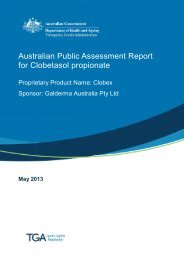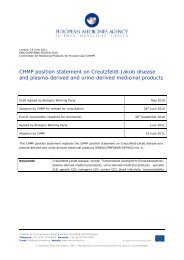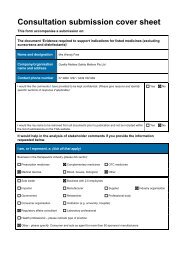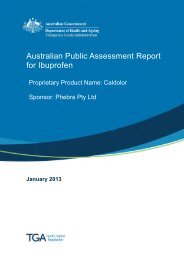AusPAR: Ivabradine - Therapeutic Goods Administration
AusPAR: Ivabradine - Therapeutic Goods Administration
AusPAR: Ivabradine - Therapeutic Goods Administration
You also want an ePaper? Increase the reach of your titles
YUMPU automatically turns print PDFs into web optimized ePapers that Google loves.
<strong>AusPAR</strong> Coralan <strong>Ivabradine</strong> Servier Laboratories (Australia) Pty Ltd PM-2010-03269-3-3<br />
Final 31 October 2012<br />
<strong>Therapeutic</strong> <strong>Goods</strong> <strong>Administration</strong><br />
Table 4. Incidence of the primary composite endpoint and components (secondary<br />
endpoints) in the RS-BB-dose<br />
Subgroup analysis of the primary composite endpoint in the RSBBdose population<br />
showed an effect in favour of ivabradine in all the pre specified subgroups except for the<br />
subgroup “age ≥ 65 years” where the hazard ratio was 1.04. In addition, the subgroup of<br />
“males” showed a negligible effect in favour of ivabradine (hazard ratio of 0.99). All the<br />
interaction tests had p-values higher than 0.05 except for the subgroup of gender, showing<br />
that the effect of ivabradine was greater in females than in males in this analysis set (p =<br />
0.0177).<br />
The results of the main secondary efficacy outcomes in the RS population are tabulated in<br />
Table 5. Secondary non-composite endpoints relating to mortality showed that there was<br />
a 26% reduction in relative risk in deaths from heart failure and this was found to be<br />
statistically significant (p = 0.014). There was a relative risk reduction of 10% in all-cause<br />
mortality and 9% in cardiovascular mortality but the reductions were not statistically<br />
significant (p= 0.092 and p= 0.128, respectively). Secondary non-composite endpoints<br />
relating to hospitalisations showed statistically significant reduction in relative risks in the<br />
ivabradine treatment group compared to the placebo group, for hospitalisations for<br />
worsening heart failure, for all-cause hospitalisations and for cardiovascular<br />
hospitalisation (relative risk reduction of 26% [p
















